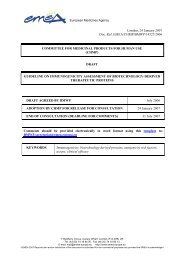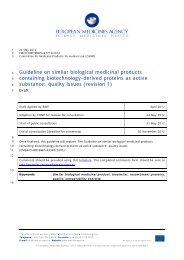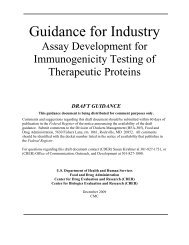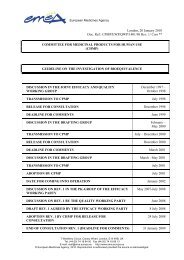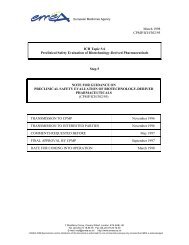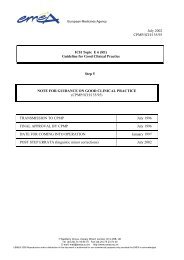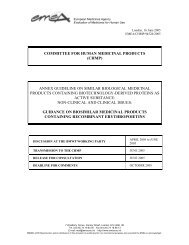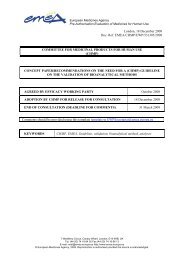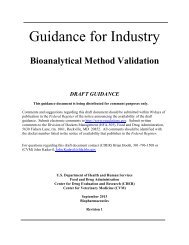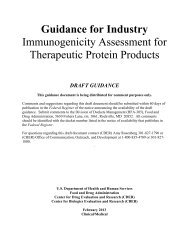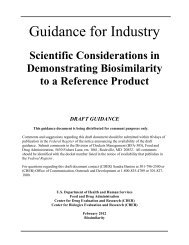Guidance for Industry - Assay Development
Assay Development for Immunogenicity Testing of Therapeutic Proteins, Draft Guidance http://www.ipm-biotech.de/fileadmin/user_upload/pdf/guidelines/FDA-GUIDANCE-Assay-Development-Immunogenicity-Testing.pdf
Assay Development for Immunogenicity Testing of Therapeutic Proteins, Draft Guidance
http://www.ipm-biotech.de/fileadmin/user_upload/pdf/guidelines/FDA-GUIDANCE-Assay-Development-Immunogenicity-Testing.pdf
Create successful ePaper yourself
Turn your PDF publications into a flip-book with our unique Google optimized e-Paper software.
472<br />
473<br />
474<br />
475<br />
476<br />
477<br />
478<br />
479<br />
480<br />
481<br />
482<br />
483<br />
484<br />
485<br />
486<br />
487<br />
488<br />
489<br />
490<br />
491<br />
492<br />
493<br />
494<br />
495<br />
496<br />
497<br />
498<br />
499<br />
500<br />
501<br />
502<br />
503<br />
504<br />
505<br />
506<br />
507<br />
508<br />
509<br />
510<br />
511<br />
512<br />
513<br />
514<br />
515<br />
516<br />
517<br />
A. Validation of Screening <strong>Assay</strong><br />
1. Sensitivity<br />
Contains Nonbinding Recommendations<br />
Draft — Not <strong>for</strong> Implementation<br />
The applicant should determine the sensitivity of the assay to have confidence when reporting<br />
immunogenicity rates. A purified preparation of antibodies specific to the product should be<br />
used to determine the sensitivity of the assay so assay sensitivity can be reported in mass<br />
units/ml of matrix. Antibodies used to assess sensitivity can take the <strong>for</strong>m of affinity purified<br />
polyclonal preparations, or monoclonal antibodies. FDA recognizes that the purification process<br />
may result in loss of low avidity antibodies. There<strong>for</strong>e, the applicant should evaluate antibody<br />
avidity be<strong>for</strong>e and after purification as part of reagent characterization.<br />
<strong>Assay</strong> sensitivity represents the lowest concentration at which the antibody preparation<br />
consistently produces either a positive result or a readout equal to the cut point (defined below)<br />
determined <strong>for</strong> that particular assay. As assessment of patient antibody levels will occur in the<br />
presence of biological matrix, testing of assay sensitivity should be per<strong>for</strong>med with the relevant<br />
dilution of the same biological matrix (e.g., normal human serum, plasma). The final sensitivity<br />
should be expressed as mass of antibody detectable/ml of matrix. Based on data from completed<br />
clinical trials, FDA recommends that screening assays achieve a sensitivity of approximately 250<br />
- 500 ng/ml as such antibody concentrations have been associated with clinical events.<br />
2. Specificity<br />
Demonstrating assay specificity is critical to the interpretation of immunogenicity assay results.<br />
This can be challenging because of the presence of product and process related impurities (such<br />
as host cell proteins) and serum factors. When the therapeutic protein represents an endogenous<br />
human protein, the applicant should asses cross reactivity with the native human protein.<br />
Similarly, when the therapeutic protein is a member of a family of homologous proteins, the<br />
applicant should assess cross reactivity with multiple family members. Demonstrating the<br />
specificity of antibody responses to monoclonal antibodies and Ig-fusion proteins poses<br />
particular challenges. The applicant should clearly demonstrate that the assay method<br />
specifically detects anti-monoclonal antibodies and not the monoclonal antibody product itself,<br />
non-specific endogenous antibodies, or antibody reagents used in the assay. Similarly, <strong>for</strong><br />
patient populations with a high incidence of RF, the applicant should demonstrate that RF does<br />
not interfere with the detection method.<br />
Perhaps the most straight<strong>for</strong>ward approach to addressing specificity is to demonstrate that<br />
binding can be blocked by soluble or unlabeled purified product. Specifically, positive and<br />
negative control antibody samples should be incubated with the purified protein under<br />
consideration or an irrelevant protein. The reduction in response can then be determined. For<br />
responses to monoclonal antibody products, inclusion of another monoclonal with the same Fc<br />
but different variable region can be critical. If the assay is specific <strong>for</strong> the protein in question,<br />
the addition of specific soluble protein should reduce the response to background or the cut point<br />
whereas the addition of an unrelated protein of similar size and charge should have no effect.<br />
Conversely, addition of specific protein should have little effect on negative antibody control<br />
samples.<br />
C:\8495dft.doc<br />
11/4/09<br />
12




